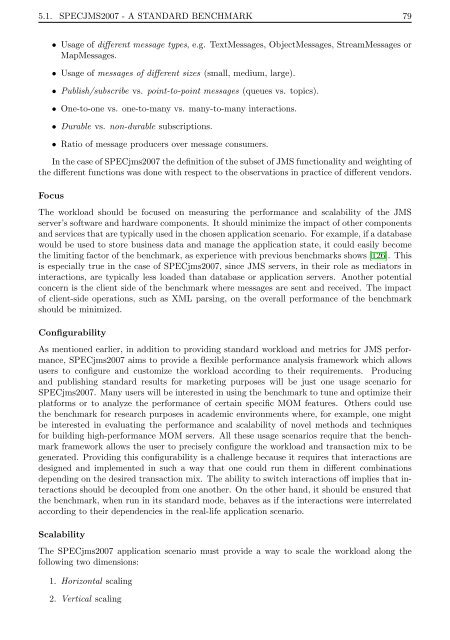Performance Modeling and Benchmarking of Event-Based ... - DVS
Performance Modeling and Benchmarking of Event-Based ... - DVS
Performance Modeling and Benchmarking of Event-Based ... - DVS
You also want an ePaper? Increase the reach of your titles
YUMPU automatically turns print PDFs into web optimized ePapers that Google loves.
5.1. SPECJMS2007 - A STANDARD BENCHMARK 79<br />
• Usage <strong>of</strong> different message types, e.g. TextMessages, ObjectMessages, StreamMessages or<br />
MapMessages.<br />
• Usage <strong>of</strong> messages <strong>of</strong> different sizes (small, medium, large).<br />
• Publish/subscribe vs. point-to-point messages (queues vs. topics).<br />
• One-to-one vs. one-to-many vs. many-to-many interactions.<br />
• Durable vs. non-durable subscriptions.<br />
• Ratio <strong>of</strong> message producers over message consumers.<br />
In the case <strong>of</strong> SPECjms2007 the definition <strong>of</strong> the subset <strong>of</strong> JMS functionality <strong>and</strong> weighting <strong>of</strong><br />
the different functions was done with respect to the observations in practice <strong>of</strong> different vendors.<br />
Focus<br />
The workload should be focused on measuring the performance <strong>and</strong> scalability <strong>of</strong> the JMS<br />
server’s s<strong>of</strong>tware <strong>and</strong> hardware components. It should minimize the impact <strong>of</strong> other components<br />
<strong>and</strong> services that are typically used in the chosen application scenario. For example, if a database<br />
would be used to store business data <strong>and</strong> manage the application state, it could easily become<br />
the limiting factor <strong>of</strong> the benchmark, as experience with previous benchmarks shows [126]. This<br />
is especially true in the case <strong>of</strong> SPECjms2007, since JMS servers, in their role as mediators in<br />
interactions, are typically less loaded than database or application servers. Another potential<br />
concern is the client side <strong>of</strong> the benchmark where messages are sent <strong>and</strong> received. The impact<br />
<strong>of</strong> client-side operations, such as XML parsing, on the overall performance <strong>of</strong> the benchmark<br />
should be minimized.<br />
Configurability<br />
As mentioned earlier, in addition to providing st<strong>and</strong>ard workload <strong>and</strong> metrics for JMS performance,<br />
SPECjms2007 aims to provide a flexible performance analysis framework which allows<br />
users to configure <strong>and</strong> customize the workload according to their requirements. Producing<br />
<strong>and</strong> publishing st<strong>and</strong>ard results for marketing purposes will be just one usage scenario for<br />
SPECjms2007. Many users will be interested in using the benchmark to tune <strong>and</strong> optimize their<br />
platforms or to analyze the performance <strong>of</strong> certain specific MOM features. Others could use<br />
the benchmark for research purposes in academic environments where, for example, one might<br />
be interested in evaluating the performance <strong>and</strong> scalability <strong>of</strong> novel methods <strong>and</strong> techniques<br />
for building high-performance MOM servers. All these usage scenarios require that the benchmark<br />
framework allows the user to precisely configure the workload <strong>and</strong> transaction mix to be<br />
generated. Providing this configurability is a challenge because it requires that interactions are<br />
designed <strong>and</strong> implemented in such a way that one could run them in different combinations<br />
depending on the desired transaction mix. The ability to switch interactions <strong>of</strong>f implies that interactions<br />
should be decoupled from one another. On the other h<strong>and</strong>, it should be ensured that<br />
the benchmark, when run in its st<strong>and</strong>ard mode, behaves as if the interactions were interrelated<br />
according to their dependencies in the real-life application scenario.<br />
Scalability<br />
The SPECjms2007 application scenario must provide a way to scale the workload along the<br />
following two dimensions:<br />
1. Horizontal scaling<br />
2. Vertical scaling















